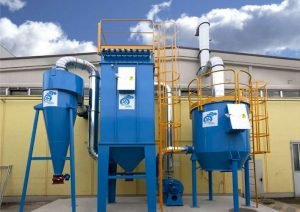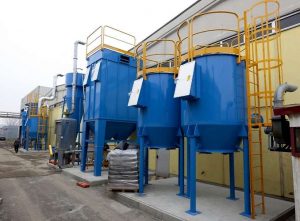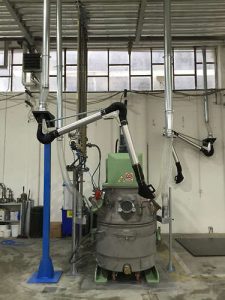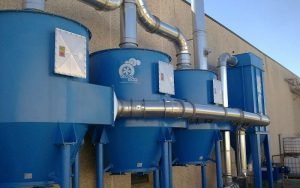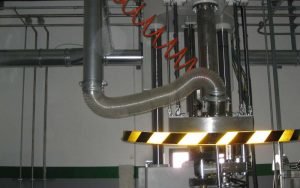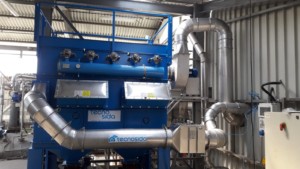Multi-stage, atex compliant turn-key systems for dust filtration – VOC abatement
How we made it and what we used: three important challanges to solve big customer’s needs in chemicals, adhesives and cosmetics production
Application 1: Adhesives and home-care chemicals production…special needs!
The customer presented in this case-history is a global company and a world leader in adhesives, cosmetic, detergents and home-care products.
During the assessment-step related to a new production plant construction, the customer contacts Tecnosida® requiring project evaluation and design for two VOC abatement systems deeply customized on production process needs.
Chemical intermediates and raw materials (such as epoxy and silicone resins) are extensively used in the production lines; these substances contain variable amounts of calcium carbonate, carbon black and crosslinking resins.
Given the explosive nature of the compounds, the system Tecnosida puts forward shall comply with ATEX norms.
Dust and VOC treatment
After a technical site inspection, Tecnosida® designed a complete solution that guarantees:
- an adequate air suction, in order to protect internal users and workers in production facilities;
- a sealed piping network to convey gaseous substances and vapors, with flexible drop lines and shutters for local collection points exclusion;
- a multi-stage filtration system with:
- dust collectors as pre-filtering stage
- active carbon adsorbers for VOC treatment and control
The complete system was designed to meet specifical binding requirements of italian health and environment legislation.
Step 1 – Collection and air ventilation
Tecnosida® designs a suction and ventilation line composed of 20 collection points able to capture all pollutants directly at the source. The whole system was projected and balanced with regards to the possibility, given to each user/point, to open/close the local suction point due to non-continuous activities developed.
According to specific dimensions, quality and profile of each operative area, suction arms, hoods and fittings were selected and applied to ensure best efficency and efficacy.
All the system, and each one of the components, has been designed in accordance with the ATEX directive 94/9/CE-99/92/CE DPR126/98 and completed with an equipotential connection of metal mass for grounding.
Step 2 – Air Filtration
Due to the mixed nature of main pollutants to be treated, two air treatment lines have been designed and manufactured, was given installation to a multi-stage abatement systems.
Pre-filter
An ATEX II 3 D certified cyclone system, made of carbon steel for dusty compounds pre-separation was designed and installed. This stage is used to pre-separate dust up to a certain granulometry and was completed with rotary valve for discharge.
Dust collector
A Dustdown® self-cleaning bag filter was installed to remove fine dust and particulate matter (PM). This filter was equipped with anti-explosion safety panels and designed to comply with ATEX standard;
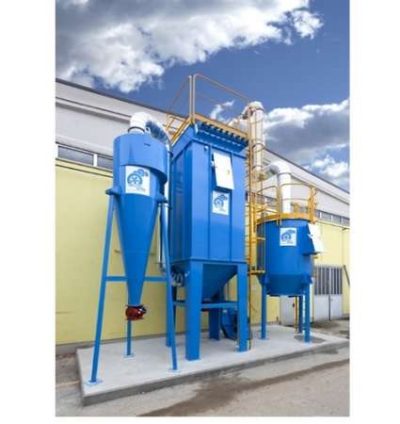
Activated Carbon Filter
Finally, a Chemsorb® active carbon purifier for adsorption of fumes and chemical vapors (VOC) present in the flow was designed and installed. This purifier was equipped with safety panels and is ATEX II 3 GD compliant too.
Step 3 : VOC abatement system commissioning and Testing
The turnkey system delivery included electrical panel, connection of utilities and pressure inverters / stabilizers for ventilation management.
Our specialized technicians have carried out final testing and calibration of all managed parameters of the plant.
Tecnosida® multi-stage filtration systems were realized in compliance with Lombardy BAT- Best Available Technologies (D.MF.01, AC.RI.01 and D.MM.01) and was able to reduce pollutants emissions in compliance with all limits established by national and local legislation.
Application 2: Chemical specialities and intermediates production
The customer presented in this case history is a global company that operates in the chemical sector developing, producing and marketing chemical specialties and intermediate products. For this reasons production processes considered here are dedicated to create multiple compounds, including anionic and cationic surfactants, polyurethanes, adhesives, sealants and chemicals specialities for textile industry.
For its typical production processes, the chemical plant where the solution described below was adopted shows a non-stop (24h) operation system and is characterized by complex connection points, many mixing areas, vat and piece washing equipments and component/raw materials loading units. With such a different and distributed range of process, sub-process and operations, the first step taken into account was an internal assessment to define which specific needs were relevant as far air pollution control was concerned.
The output of this analysis indicated that there was a clear necessity to:
- to capture and break down powders, both from mineral and polymeric matrix
- to treat solvent vapors (VOC) containing traces of isocyanates also.
The two groups of pollutants listed above, besides, were mixed toghether and is mixture of dust and solvents, in relation to its chemical-physical characteristics, could be flammable and even explosive.
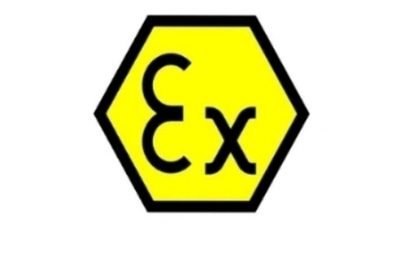
This elements indicated that all filtration and abatement system should be designed and manufactured in accordance with the ATEX European directive.
Turnkey multi-stage filtration system
Following a careful on-site technical inspection, Tecnosida® proposes the construction of a multi-stage abatement system for dedusting, conveying and VOC treatment.
Pollutants collection
The collection step was performed through suction arms and hoods specially sized according to the geometry of the production machines and the specific suction needs. In this application the components are all ATEX certified in order to be used in a potentially explosive atmosphere
Ventilation system
Air conveyoring was performed through the installation of specifically designed pipes used to bring air and pollutants from the sourcing area to the VOC abatement system;
Multi-stage abatement system
- In the first stage is performed dust filtration. This process is carried out through a Dustdown® bag filter which is particularly suitable to remove fine and ultrafine dust and particulate. The filter was designed and equipped to be ATEX compliant and included specific components such as anti-explosion safety panels.
- In the second stage three parallel activated carbon filters Chemsorb® were deisgned to allow a challanging break down phase for vapors and VOCs deriving from solvents use. These purifiers were realized in vertical version and in compliance with ATEX directive.
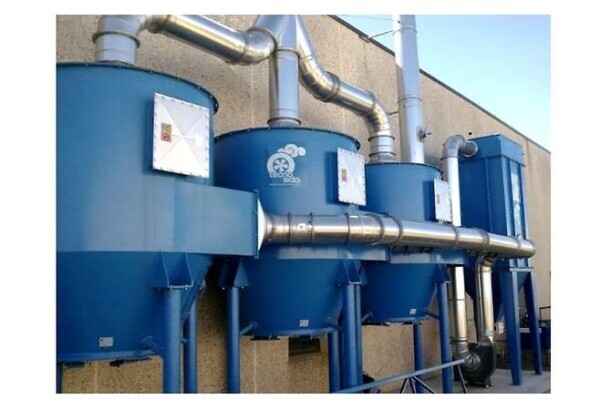
The plant was built in compliance with Italian (Lombardy) BAT Best Available Technologies (D.MF.01 and AC.RI.01) and was able to reduce the emissions of pollutants well below manadatory legal limits, thus solving the customer’s problems.
Application 3: insecticide production
In this third case history we go to describe an application referred to the production and packaging of liquid chemical products for plant protection and biocides for civil and professional use.
The customer contacted Tecnosida® for the replacement of a dust filtration system serving two mixers used for the production of insecticides and herbicides. The existing system was not compliant with current regulations (in particular the ATEX one) and did not respond to the needs of the customer because, over the years, the production lines were modified.
The Company also asked Tecnosida® to increase the filtering surface (50% more than the existing system), in order to increase operability.
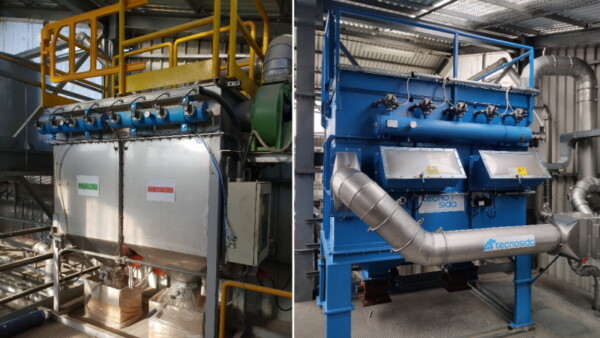
ATEX bag filter for insecticide powders
After the initial contact, Tecnosida® carried out a technical-economic inspection during which customer’s needs and critical issues related to the available space were analyzed. In the specific case, there was a need for:
- connect our system to the existing suction system;
- place the system, in particular the filter, on a deck characterized by small dimensions (the height at the highest point was about 3m)
For these reasons, Tecnosida® designed a custom system, tailored to actual available space. This entailed the use of reduced height filter bags and the need to adapt all other components.
The ATEX dust filter was made of stainless steel and is composed of:
- Settling chamber: it is placed at the filter inlet to slow down and distribute the air flow. It allows to settle the coarse dust and decrease the concentrations of pollutants that come into contact with the sleeves. This technical measure is used to preserve the filtering elements when there are pollutants which could damage the sleeves (for example, hygroscopic and abrasive powders)
- Filtering section: composed of sleeves made of water and oil repellent antistatic material;
- Hoppers complete with electric motor-vibrators: normally, the dust discharge hoppers must have an inclination greater than 50 degrees. This is necessary to facilitate the flow of the pollutant along the walls and, consequently, the discharge of the same. In this case, due to the limited spaces, it was not possible to guarantee a sufficient inclination therefore electric motor-vibrators were applied to the two hoppers. With their movement, they shake the walls of the hoppers and facilitate the fall of the powders avoiding their accumulation. For the discharge of residues, ATEX certified star valves have been applied in the terminal part of the hoppers. They also act as a compartmentalization of the filter in the event of an explosion. Containers were then placed under the valves to collect the pollutant;
- Breakage panel: the filter is positioned in the ATEX area and treats potentially explosive dust; for this reason it has been equipped with safety panels to vent any explosion. As can be seen from the image, they are placed on the front of the filter and allow to discharge outside the pressure deriving from a possible explosion inside the dust collector. This component allows to safeguard the structure of the filter and protect the surrounding environment. For safety reasons, the customer then proceeded to create conveying pipes which, in the event of an explosion, allow the pressure to be released over the roof of the building
The system is also composed of:
- Conveying pipes: allow the connection between the existing suction pipe and the filter; and between the centrifugal fan and the exhaust pipes;
- Non-return valve: located upstream of the filter and, in the event of an explosion, prevents the propagation of the deflagration along the suction pipe;
- Electrical panel: used to control the system. In this application it is equipped with an inverter which, based on production and operational needs, ensures better regulation of the air flow with consequent energy savings. The electrical panel was created for the connection of ATEX utilities, but was positioned in a non-ATEX area.
As we have seen, the system and all its components have been manufactured in compliance with ATEX Directive and BAT reference cards.
